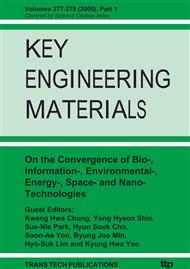p.56
p.62
p.67
p.72
p.77
p.82
p.90
p.96
p.102
Controlled Release of Growth Factor Using Poly(N-Isopropyl Acrylamide)Copolymer Hydrogels with Different Volume Phase Transition Temperatures
Abstract:
The release behavior of the basic fibroblast growth factor (bFGF) from copolymer hydrogels of N-isopropyl acrylamide (NIPAAm) and sodium methacrylate (SMA) was investigated in relation to the volume phase transition temperatures, which was increased by the incorporation of SMA. In the case of the copolymer hydrogels, a higher volume phase transition temperature was obtained when poly(ethylene glycol) diacrylate (PEGDA) was used as the crosslinking agent, suggesting that the chain length of the crosslinking agent has a significant affect on the volume phase transition temperature of a P(NIPAAm-co-SMA) hydrogel. The concentration of bFGF released from the hydrogels with PEGDA increased relative to the water content, thereby showing a dependence on the volume phase transition temperature. Hence, the release behavior of bFGF from the PNIPAAm and P(NIPAAm-co-SMA) hydrogels was found to be affected by the volume phase transition temperature, which can be easily controlled by changing the comonomer, monomer feed ratio, and crosslinking agent.
Info:
Periodical:
Pages:
77-81
Citation:
Online since:
January 2005
Authors:
Price:
Сopyright:
© 2005 Trans Tech Publications Ltd. All Rights Reserved
Share:
Citation:


